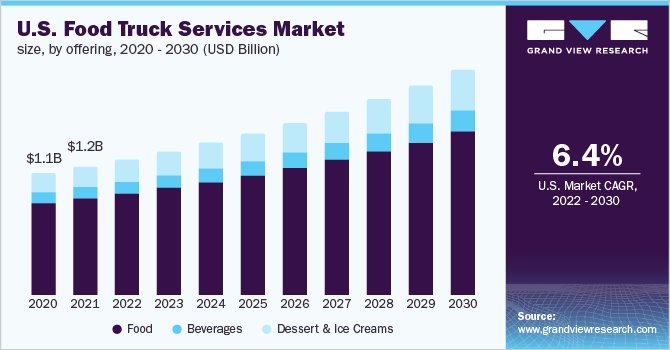The food truck industry has surged in popularity over the past decade, transforming from a niche market into a significant segment of the American culinary landscape. As of 2022, food trucks have solidified their place in the hearts (and stomachs) of many Americans, with their unique blend of convenience, innovation, and culinary diversity. This article delves into the latest statistics and trends shaping the food truck industry in the US for 2022, exploring market growth, key demographics, financial insights, and the challenges faced by food truck operators.
Market Growth and Size
The US food truck industry has demonstrated impressive growth, with 2022 being a standout year. According to recent market research, the industry was valued at approximately $1.2 billion in 2022, reflecting a notable increase from previous years. This growth is driven by several factors, including rising consumer demand for diverse and gourmet food options, lower startup costs compared to traditional restaurants, and the flexibility that food trucks offer.
Annual Growth Rate
The food truck sector has experienced a compound annual growth rate (CAGR) of around 8% over the past five years. This robust growth is indicative of a broader trend toward mobile dining experiences and the increasing popularity of food trucks among millennials and Gen Z. The industry's resilience, even during economic downturns, underscores its adaptability and appeal.
Key Demographics and Consumer Trends
Consumer Preferences
Food trucks cater to a diverse clientele, but certain demographics stand out. Millennials and Gen Z are the primary patrons of food trucks, drawn to the variety of cuisines and the unique dining experiences they offer. These younger consumers value the fusion of high-quality food and affordability that food trucks provide. Additionally, food trucks have become a popular choice for foodies seeking novel and innovative dishes.
Geographic Distribution
The popularity of food trucks is not uniform across the United States. Urban areas, particularly those with vibrant cultural scenes, see the highest concentration of food trucks. Cities like Los Angeles, New York, and Portland are known for their thriving food truck communities. However, smaller cities and suburban areas are also seeing a rise in food truck operations, expanding the market reach and accessibility.
Financial Insights and Revenue Streams
Startup Costs and Profit Margins
Starting a food truck business generally requires lower initial investment compared to opening a brick-and-mortar restaurant. The average startup cost for a food truck in 2022 ranges between $50,000 and $150,000, which covers the truck itself, kitchen equipment, and licensing. Despite the lower entry costs, food truck operators face significant ongoing expenses, including fuel, maintenance, and ingredient costs.
Profit margins in the food truck industry are typically higher than those of traditional restaurants, due to lower overhead costs. However, margins can fluctuate based on location, menu pricing, and operational efficiency. Successful food trucks often achieve profit margins between 10% and 15%, with top-performing trucks reaching up to 25%.
Revenue Potential
The revenue potential for food trucks varies widely. On average, a well-established food truck can generate annual revenues of $250,000 to $500,000. High-demand trucks in prime locations can exceed these figures, particularly those that leverage social media marketing and participate in popular food festivals and events.
Industry Challenges and Risks
Regulatory Compliance
One of the significant challenges facing food truck operators is navigating the complex web of local regulations and health codes. Compliance with health and safety standards, obtaining permits, and adhering to zoning laws can be time-consuming and costly. Regulations vary by city and state, requiring food truck owners to stay informed and adaptable.
Competition and Market Saturation
As the food truck industry grows, so does the level of competition. New entrants must differentiate themselves through unique offerings, exceptional customer service, and strategic marketing. In highly competitive markets, food trucks must continuously innovate to stay relevant and attract customers.
Seasonal Fluctuations
Food trucks often experience seasonal fluctuations in business. Weather conditions, local events, and holidays can significantly impact revenue. For instance, food trucks in colder climates may see reduced business during winter months, while those in warmer regions may benefit from year-round operations.
Emerging Trends in the Food Truck Industry
Technology Integration
Technology is playing an increasingly crucial role in the food truck industry. Mobile ordering apps, online payment systems, and social media marketing have become essential tools for attracting and retaining customers. Food trucks that effectively utilize these technologies can enhance customer experience, streamline operations, and boost sales.
Sustainable Practices
Sustainability is becoming a key focus for many food truck operators. From using locally sourced ingredients to adopting eco-friendly packaging, food trucks are embracing practices that reduce their environmental footprint. This shift towards sustainability aligns with the growing consumer demand for environmentally conscious dining options.
Gourmet and Specialty Foods
The trend toward gourmet and specialty foods continues to influence the food truck industry. Many operators are moving beyond traditional street food offerings to include high-end, artisanal, and globally inspired dishes. This focus on unique and high-quality food experiences helps food trucks stand out in a crowded market.
The US food truck industry in 2022 reflects a dynamic and rapidly evolving market. With significant growth, a diverse customer base, and innovative trends, food trucks have become a prominent and influential part of the American dining scene. While challenges such as regulatory compliance and competition exist, the industry's resilience and adaptability highlight its ongoing potential.
As we look ahead, the food truck industry is poised to continue its expansion, driven by consumer preferences for convenience, diversity, and quality. For entrepreneurs and investors, the food truck market presents a promising opportunity to engage with a vibrant and growing sector of the culinary world.




















